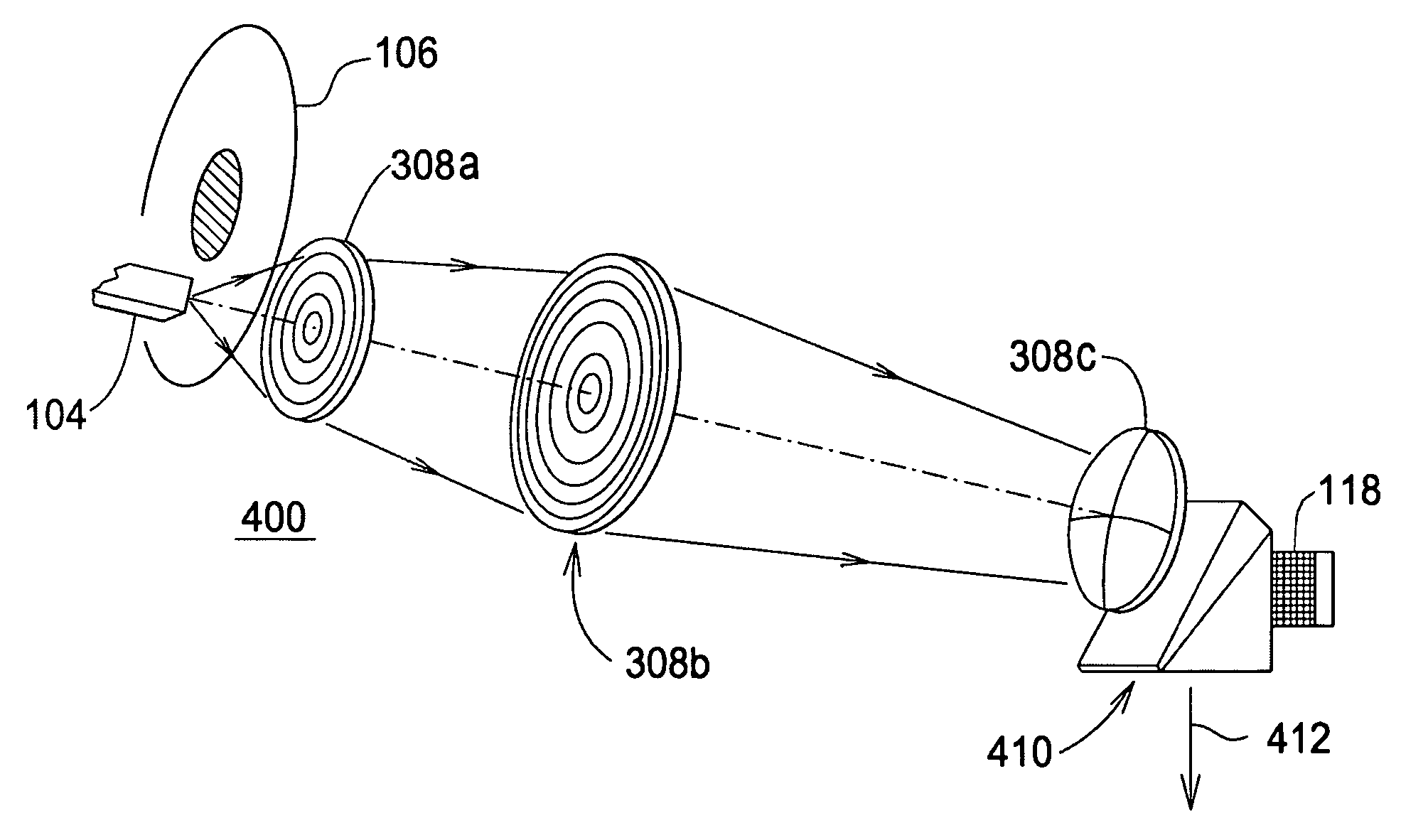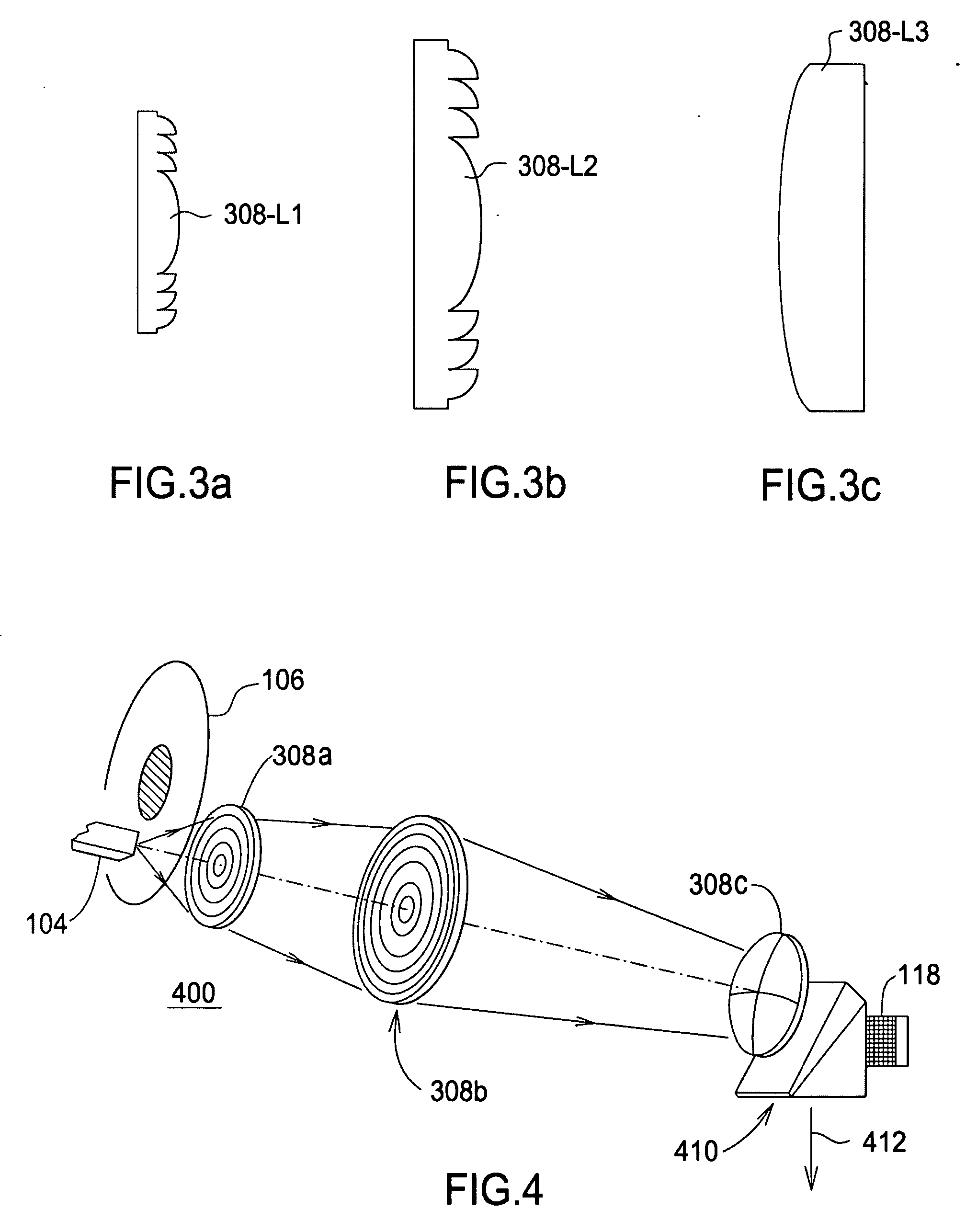Projection illumination systems lenses with diffractive optical elements
a technology of diffractive optical elements and projection display, which is applied in the field of projection display, can solve the problems of chromatic aberration, heavy weight of aspherical glass lenses, and high cost of fabrication, and achieves the effect of easy manufacturing and light weigh
- Summary
- Abstract
- Description
- Claims
- Application Information
AI Technical Summary
Benefits of technology
Problems solved by technology
Method used
Image
Examples
first embodiment
[0028]FIG. 3 is a side view of lenses 308-L1, 308-L2, and 308-L3 forming the illumination system optics according to the present invention. In this particular embodiment, lens 308-L1 is a refractive fresnel lens and lens 308-L2 is a lens which comprises a refractive as well as a diffractive fresnel lens, while lens 308-L3 is a conventional refractive lens. FIG. 3 does not show that lens 308-L2 includes a surface with a diffractive fresnel lens used to correct for chromatic aberrations. This is shown in FIGS. 6-8. In the example of FIGS. 6-8 the diffractive fresnel lens is a kinoform. This combination has been shown to work well, but many variations are possible. For example, all three lenses could comprise refractive fresnel lenses (or conventional lenses). More than one of the lenses could include such a diffractive optical element.
[0029]FIG. 4 is a side isometric view of a projection system 400 utilizing the illumination system optics of FIG. 3. This system is somewhat similar to ...
second embodiment
[0038]FIGS. 7A and B show lens 308-L1. Again, FIG. 7B is blown up from a portion of FIG. 7A, and greatly exaggerated for detail. This embodiment is similar to that of FIGS. 6A and 6B, except that the kinoforms are formed on top of the fresnel structure.
[0039] A prototype version of this embodiment was fabricated by diamond turning the plastic lens on a special lathe which carved the plastic. In commercial fabrication, a similar process could be used, but to form a mold which would then be used to form the lenses.
third embodiment
[0040]FIGS. 8A and 8B show a third embodiment, which is a variation of lens 308-L1. Again, FIG. 8B is blown up from a portion of FIG. 8A, and greatly exaggerated for detail. The embodiment of FIGS. 8A and 8B is based on a conventional lens, rather than a fresnel lens, and has the kinoforms formed on the curved surface of the lens. As an alternative, kinoforms could be formed on a flat surface of a conventional lens having a flat surface.
[0041] The embodiment of FIGS. 8A and 8B sacrifices the light weight and size of a fresnel lens, but maintains the color performance provided by the kinoforms. Hence it is useful in some configurations.
[0042] It will be appreciated by one versed in the art that there are many possible variations on these designs. Some known and anticipated variations are described below:
[0043] Any lens which results in the desired diffraction as produced by the specific embodiments described above is encompassed within the present invention. The specific embodiment...
PUM
 Login to View More
Login to View More Abstract
Description
Claims
Application Information
 Login to View More
Login to View More - R&D
- Intellectual Property
- Life Sciences
- Materials
- Tech Scout
- Unparalleled Data Quality
- Higher Quality Content
- 60% Fewer Hallucinations
Browse by: Latest US Patents, China's latest patents, Technical Efficacy Thesaurus, Application Domain, Technology Topic, Popular Technical Reports.
© 2025 PatSnap. All rights reserved.Legal|Privacy policy|Modern Slavery Act Transparency Statement|Sitemap|About US| Contact US: help@patsnap.com



